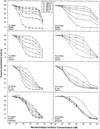Evaluation of neuraminidase enzyme assays using different substrates to measure susceptibility of influenza virus clinical isolates to neuraminidase inhibitors: report of the neuraminidase inhibitor susceptibility network
- PMID: 12574276
- PMCID: PMC149673
- DOI: 10.1128/JCM.41.2.742-750.2003
Evaluation of neuraminidase enzyme assays using different substrates to measure susceptibility of influenza virus clinical isolates to neuraminidase inhibitors: report of the neuraminidase inhibitor susceptibility network
Abstract
The increasing use of influenza virus neuraminidase (NA) inhibitors (NIs) necessitates the development of reliable methods for assessing the NI susceptibility of clinical isolates. We evaluated three NA inhibition assays against a panel of five clinical isolates each of influenza virus A/H1N1, A/H3N2, and B strains and four viruses with a defined resistance genotype (R292K, H274Y, R152K, and E119V). For fluorometric enzyme assay (FA) 1 (FA-1), 2'-(4-methylumbelliferyl)-alpha-D-N-acetylneuraminic acid (MUNANA) at 100 microM was used as the substrate, with pretitration of the virus input. For FA-2, MUNANA at 200 microM was used as the substrate, with a fixed 1:10 dilution of input virus. For the chemiluminescence (CL) assay, the 1,2-dioxetane derivative of sialic acid at 100 microM was used as the substrate, with pretitration of the virus. Four different operators repeated the assays several times in a blinded fashion with both zanamivir and oseltamivir carboxylate (GS4071) to determine intra- and interassay variations. Mean 50% inhibitory concentration (IC(50)) values were lower and generally less variable with the CL assay. FA-1 displayed greater variation than the CL assay or FA-2 and the highest IC(50) values with zanamivir; FA-2 showed the highest values with oseltamivir, particularly for influenza virus B, and was more variable with zanamivir than was the CL assay. All three assays detected 40-fold or greater changes in IC(50) values for the resistant viruses with at least one drug. Mixing experiments, whereby increasing fractions (0, 20, 40, 60, 80, and 100%) of NA from a known NI-resistant virus were mixed with the corresponding NI-sensitive parental NA, indicated that the resolution of IC(50) values was clearer with the CL assay than with FA-2 for two of the resistant variants (R152K and E119V). The FA and CL methods were reliable for the detection of NI resistance, but all assays have certain limitations. Based on reproducibility, ease of automation, time required for the assay, and greater sensitivity, the CL assay was selected for future susceptibility testing of influenza virus isolates circulating globally.
Figures

References
-
- Babu, Y. S., P. Chand, S. Bantia, P. L. Kotian, A. Dehghani, Y. El-Kattan, T. Lin, T. L. Hutchinson, A. J. Elliott, C. D. Parker, S. L. Ananth, L. L. Horn, G. W. Laver, and J. A. Montgomery. 2000. BCX-1812 (RWJ-270201): discovery of a novel, highly potent, orally active, and selective influenza neuraminidase inhibitor through structure-based drug design. J. Med. Chem. 43:3482-3486. - PubMed
-
- Barnett, J. M., A. Cadman, D. Gor, M. Dempsey, M. Walters, A. Candlin, M. Tisdale, P. J. Morley, I. J. Owens, R. J. Fenton, A. P. Lewis, E. C. J. Claas, G. F. Rimmelzwaan, R. De Groot, and A. D. M. E. Osterhaus. 2000. Zanamivir susceptibility monitoring and characterization of influenza virus clinical isolates obtained during phase II clinical efficacy studies. Antimicrob. Agents Chemother. 44:78-87. - PMC - PubMed
-
- Buxton, R. C., B. Edwards, R. R. Juo, J. C. Voyta, M. Tisdale, and R. C. Bethell. 2000. Development of a sensitive chemiluminescent neuraminidase assay for the determination of influenza virus susceptibility to zanamivir. Anal. Biochem. 280:291-300. - PubMed
-
- Gubareva, L. V., M. N. Matrosovich, M. K. Brenner, R. C. Bethell, and R. G. Webster. 1998. Evidence for zanamivir resistance in an immunocompromised child infected with influenza B virus. J. Infect. Dis. 178:1257-1262. - PubMed
Publication types
MeSH terms
Substances
LinkOut - more resources
Full Text Sources
Other Literature Sources

